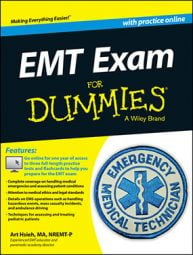You will need to know about obstetrical conditions for the EMT exam. It’s important for a woman to receive regular obstetrical care during pregnancy. Staying healthy and being aware of possible risks that may arise promote a healthy newborn infant. However, several conditions can occur during pregnancy that may require your intervention. Here is a list of these concerns, their signs and symptoms, and possible treatments.
| Condition | Signs and Symptoms | Specific Treatment |
|---|---|---|
| Abortion: An embryo is spontaneously or intentionally released from the uterine wall. | Pain, cramping, bleeding. Usually self-resolving, but incomplete abortions may result in serious bleeding. Look for signs of shock. | Treat for shock if needed — keep patient supine, maintain body temperature, administer supplemental oxygen if needed. Don’t pack the vagina to control bleeding. |
| Ectopic pregnancy: A fertilized embryo implants within or around the fallopian tube instead of in the uterus. | Increasing pain in the lower abdomen that begins 6–8 weeks after a missed menstrual period. Vaginal bleeding may occur. If bleeding becomes severe, signs of shock develop. | Suspect the condition in any female of childbearing age who complains of abdominal pain. Treat for shock if needed — keep patient supine, maintain body temperature, administer supplemental oxygen if needed. Don’t pack the vagina to control bleeding. Transport immediately. |
| Placenta abruptio: The placenta abruptly tears partially away from uterine wall. | Rapid onset of severe pain, usually in third trimester. Major bleeding from vagina, cramping. Shock signs are likely. The abdomen may be unusually rigid. | Treat for shock — keep patient supine, maintain body temperature, administer supplemental oxygen if needed. Don’t pack the vagina to control bleeding. |
| Placenta previa: The placenta grows over the cervix. | Typically seen in third trimester. Small amounts of bright red blood may be seen vaginally. Usually no pain or discomfort. | Keep patient comfortable and maintain body temperature. |
| Pregnancy-induced hypertension (preeclampsia): A mismatch of embryo and maternal tissue causes a toxic environment for the mother. | Increasing high blood pressure (140/90 mm Hg or higher), headache, swelling of the hands and feet. If situation becomes significant, patient may experience seizures (eclampsia). | Transport patient calmly and carefully. Minimize exposure to bright lights or loud sounds, as they may trigger seizures. Eclamptic seizures are life-threatening. Concentrate aggressive treatment on the mother, as that will save the baby. Do not delay transport. Support ventilations if needed. |
| Supine hypotensive syndrome: Increasing weight of the uterus presses down on the vena cava in the supine position, causing decreased blood flow back to the heart. | When leaning back or lying flat on her back, patient may feel dizzy, faint. Hypotension, tachycardia. | Lie patient on her left side to relieve pressure on vena cava. |
| Trauma during pregnancy: The 20 percent increase of blood
volume in the female during pregnancy may mask initial signs of
shock. If a mechanism of injury (MOI) exists, assume internal
hemorrhage. Later stages of pregnancy also reduce the mother’s ability to breathe as the uterus pushes up against the diaphragm. This can cause significant respiratory distress in trauma. |
Signs of an MOI to the pregnant abdomen (an improperly worn lap
belt in a motor vehicle crash, blunt trauma from a fall or assault,
penetrating trauma). Tachycardia, tachypnea. Signs of shock in later stages of bleeding. |
Immobilize if needed, place patient onto left side to avoid
supine hypotension syndrome. Provide supplemental oxygen if needed. Assist ventilations with bag-valve mask if patient is in respiratory failure. Preserve body temperature by covering patient. |

